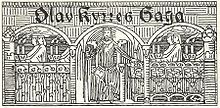Olaf III of Norway
| Olaf Kyrre | |||||
|---|---|---|---|---|---|

Gerhard Munthe: illustration for Olav Kyrres saga in Heimskringla (1899)
|
|||||
| King of Norway | |||||
| Reign | 1067 – 22 September 1093 | ||||
| Predecessor | Magnus II | ||||
| Successor | Magnus III, Haakon Magnusson | ||||
| Born | c. 1050 | ||||
| Died | 22 September 1093 (aged about 43) Haukbø, Rånrike, Norway (now Håkeby, Tanum, Sweden) |
||||
| Burial | Nidaros Cathedral | ||||
| Consort | Ingerid of Denmark | ||||
| Issue | Magnus III of Norway | ||||
|
|||||
| House | Hardrada | ||||
| Father | Harald III of Norway | ||||
| Mother | Tora Torbergsdatter | ||||
| Religion | Roman Catholicism | ||||
| Full name | |
|---|---|
| Óláfr Haraldsson |
Olaf Haraldsson (Old Norse: Óláfr Haraldsson, Norwegian: Olav Haraldsson; c. 1050 – 22 September 1093), known as Olaf Kyrre (Old Norse: kyrri, English: Peaceful), ruled Norway as (King Olaf III) from 1067 until his death in 1093.
He was present at the Battle of Stamford Bridge in England in 1066 where his father, King Harald Hardrada, saw defeat and was killed in action, an event that directly preceded his kingship. During his rule, Olaf made peace with regards to earlier royal conflicts with the church, strengthened the power of the monarchy, and is said to have founded the city of Bergen circa 1070. Around 1225, Snorri Sturluson wrote Olav Kyrres saga about King Olaf in the Heimskringla.
Olaf was a son of King Harald Hardrada and Tora Torbergsdatter. Olaf joined his father during the invasion of England during 1066. However, he was only 16 years old during the Battle of Stamford Bridge in September 1066. He stayed on a ship and did not participate in the fighting. After the Norwegian defeat, he sailed with the remains of the Norwegian strike force back to Orkney, where they wintered. The return journey to Norway took place in summer 1067.
After the death of his father, Olaf shared the kingdom with his brother Magnus II (Magnus 2 Haraldsson) who had become king the previous year. When King Magnus died during 1069, Olaf became the sole ruler of Norway.
During his reign, the nation of Norway experienced a rare extended period of peace. He renounced any offensive foreign policy, rather he protected Norway as a kingdom through agreements and marriage connections. Domestically he laid emphasis on the church's organization and modernizing the kingdom. The latter resulted in, among other things, the reorganization of the body-guard and of measures under which key cities, especially Bergen, could better serve as a royal residence. According to the Heimskringla by Snorri Sturluson, Olaf is said to have founded the city of Bergen (originally called Bjørgvin).
...
Wikipedia
